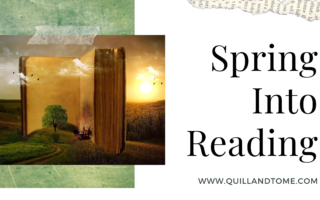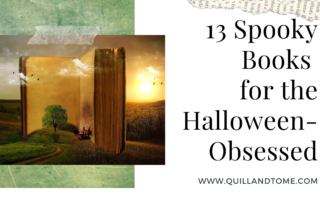A Few of My Favorite Late-Fall Stories
As the wheel of the year turns yet again and we see the face of Winter on the horizon, I begin to gather, mentally if not literally, the books I love to read at this time of year. Now that summer is long gone, stories of sunshine-filled days on the beach no longer seem relevant, nor do the early-Fall stories of back-to-school adventures and baseball fantasies.
It is now late-Fall. What I like to call “Fall-en.” The harvest has been reaped. The fields are empty. The corn stalks are long dead, if they are even still standing. The world is darker, colder, drawing me into unknown realms of dark fantasy, insanity, and murder in literature and in film. Novels read at this time of year are read by lamplight rather than sunlight; with a blanket and nice cup of chamomile tea to ward off the cold.
I find that I am often drawn to the same stories over and over, year after year. In these favorites, I see the the late-fall themes of death and descending darkness and the hope (or fear) of rebirth. These stories include an evil that never really goes away no matter how many times it is killed, a man’s descent into the Hell of his own insanity and moral destruction, and a place where time itself becomes an enemy of young and old alike, until it, too, is mastered.
Something Wicked This Way Comes

The first story that calls to me as the cycle of nature approaches Samhain, marking the death of the year, is Ray Bradbury’s Something Wicked This Way Comes. Mr. Bradbury began writing the novel of dark fantasy in 1955 based on a short story he had written many years earlier, and many of his characters were based on actual people he had met. This story begins with a carnival that arrives very late in the year – October, in fact – complete with a witch and a tattooed man. Will and his friend Jim are excited about the carnival, but Will’s father, Charles Halloway, is full of trepidation. Charles feels at age 54 that he is too old to be Will’s father, who hasn’t learned yet that mental age is what is important, that physical age is not to be trusted IF the mind is young. Most terrifying is a carousel that makes time pass as it spins, backward or forward, advancing or reversing the age of the rider. In the end, the evil of the carnival can only be destroyed by love and happiness, and by believing in the magic that will ultimately defeat the evil.
Ghost Story
The second story on this list is one that comes often to my mind as the weather turns cold and darkness comes earlier and earlier each day as we move toward winter. Ghost Story, by Peter Straub, is much, much more than just a ghost story. Peter Straub is a master teller of tales that are stories within stories, where sometimes the the story is a retelling of a story of a memory of a dream…of someone else! Most of the protagonists are elderly gentlemen, well past the summer of their lives. The Chowder Society, as they are known to themselves, get together regularly to tell ghost stories and reminisce about their adventures in their younger days. They join forces with a young writer, Don Wanderly, nephew of a Chowder Society member who suffered a mysterious death. Nightmares and unexplained events caused the elder gentlemen to summon Don for help. These men, together with a teenager, Peter Barnes, face off with a monster who is not one, but many monsters who have appeared in the lives of each man over the years. This evil being is not a typical horror-story monster, and no silver bullets and crucifixes will banish it. Worse yet, the men believe they are partly responsible for the evil currently visiting them, as they suffer the guilt of their complicity in a murder many years before. “I am you” will resonate with readers long after finishing this book.
Frankenstein

The third book in this selection is Frankenstein, by Mary Shelley. Mary was only eighteen years old when she wrote this story, which was published anonymously two years later, in 1818. While considered one of the earliest science fiction novels, it is without doubt a novel of gothic horror. In this story, a monster is created from the failed attempts of a scientist, Victor Frankenstein, to create life from reanimated dead bodies. Horrified by what he has done, and disgusted by the resulting monster, Victor rejects his creation, leaving Vienna and leaving the monster behind, to return to his family’s home in Geneva. The monster, while physically hideous, is also intelligent, and capable of reasoning and understanding. The monster learns from Victor’s own scientific journal the story of his own creation and rejection by his maker, and also experiences rejection by the people he encounters once he leaves Victor’s laboratory. Full of rage at his rejection by society and by Victor, he travels to Geneva ahead of Victor and murders Victor’s little brother, William. Only Victor knows who the murderer is, but cannot go to the police because the existence of the monster cannot be explained without implicating himself. The monster demands that Victor create for him a mate like himself, promising he would take his bride and go away where no man would ever find them, and Victor agrees, only to destroy the resulting creation before handing it over to the monster. At this latest affront, the monster vows revenge upon Victor, killing his best friend and threatening to kill Victor’s bride, which he does, on Victor’s wedding night. Victor’s pursuit of the monster (and his own conscience, perhaps) over land and sea to the Arctic circle, ends after he is rescued by the explorer Robert Walton (another man obsessed with his own ambitions). The story Victor tells the captain is unbelievable, but the captain and crew discover that what is unbelievable can also be true. In the end, Victor’s relentless pursuit of experiments in the name of science and his selfish ambitions made him as much of a monster as the one he created.
CHECK OUT THE WRITER’S PLANNER BY QUILL AND TOME!
Get the planner and organize your life and your writing!
What you can find inside:
- Plenty of writing space in a vertical layout
- Undated weekly and monthly pages you can start using any day of the year
- Reading and Writing Trackers
- Writing Tips
- and so much more!
Over To You
Hopefully, you found this helpful.
If you enjoyed this content and are interested in fitting writing into your daily life, DOWNLOAD THE FREE WORKBOOK! Read our monthly newsletter, full of valuable writing advice and be the first to know when we release a new product or book.
Happy Reading!









Ghost Story is also one of the scariest books I’ve ever read!